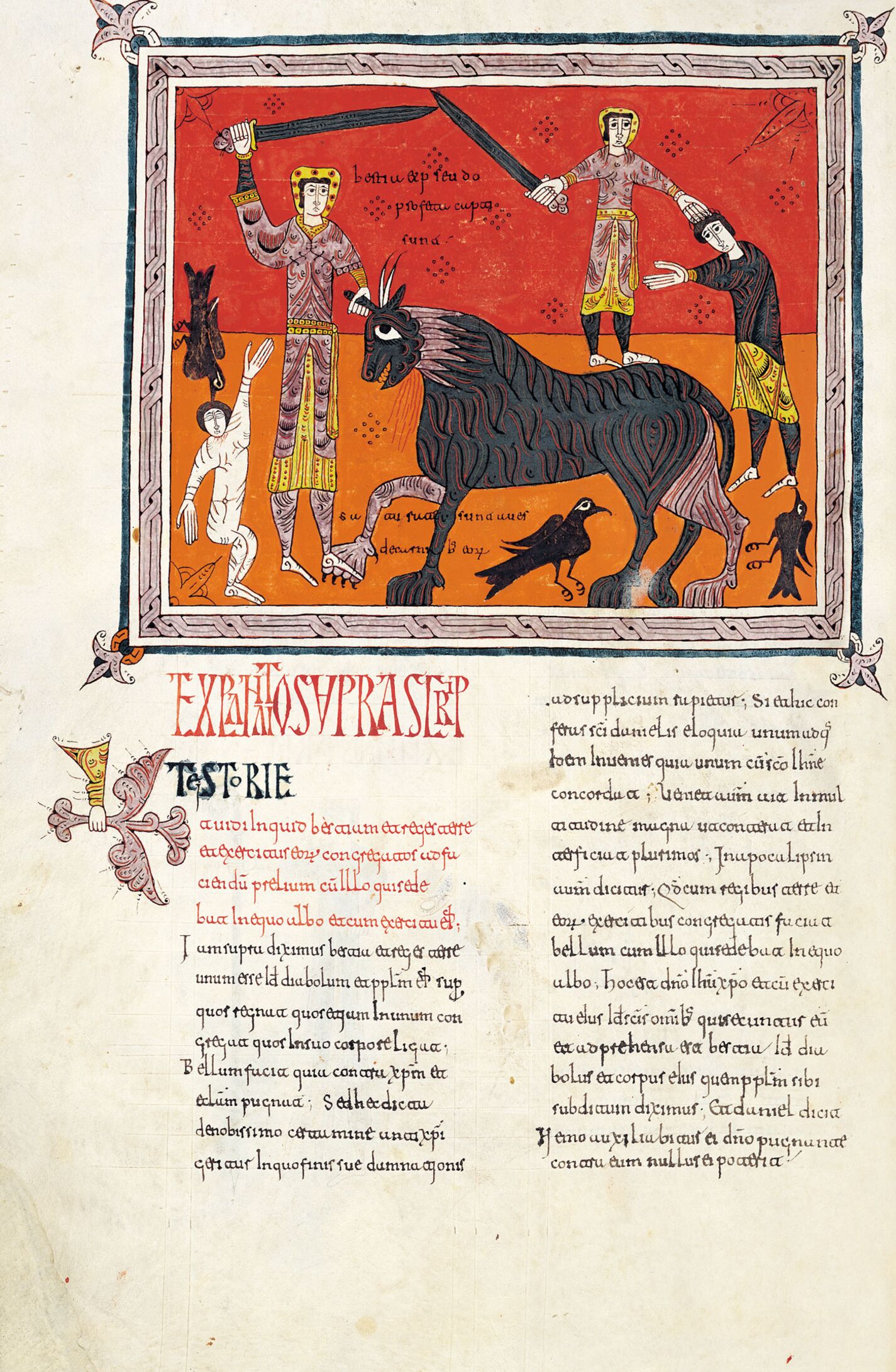f. 198v. The triumph of the rider over the beast
The beast, i.e. the devil, and the pseudo prophet – the people of evil and their chiefs – fight Christ and the Church, and are overcome. The birds shown eating are saints filling themselves with the flesh of their enemies. The interpretation of the text differs in the Beatus belonging to stemmata I and II. In the Osma Beatus (f. 152v) the beast – being ridden by a naked figure – is shown held by the muzzle. It is based on versicle 20 of the storia: bestia et pseudoprofeta capti sunt. Williams believes this may suggest that only this part of the storia was illustrated traditionally. It also features in the Beatus belonging to stemma II, whose composition is different from the previous one. This is apparently one of Maius’ creations (f. 211r). It is copied exactly in the Girona Beatus (f. 223v) and more freely by Obeco (f. 173v) and Facundus (f. 242v). Here again, the characteristics peculiar to the Silos Beatus suggest that it was inspired by a lost codex although the generic concept of the layout stems from the Morgan Beatus. In stemma II codices, the illustration shares a space with the text and covers half a folio or slightly more. The Silos Beatus features certain variations with regards to Maius more in line with the storia. The henchmen are of a higher social class and use swords instead of clubs. One henchman is about to seize the beast whilst the other raises his weapon to kill the false prophet. One crow is about to peck one of the prophet’s feet whilst another stares at him threateningly and is about to fly at him. Yet another bird pecks the head of a naked corpse shown standing upright due to a lack of space. The text saturate sunt aves / de carnib[us] eor[um] explains the mission of the ravenous birds.
This initial E[t uidi inquid bestiam...] consists of the usual formula of a human hand grasping a branch with two developed foliate leaves and a palm leaf between them extending backwards. Violet colour with black and yellow lines.
Ángela Franco Mata
(Head of the Department of Mediaeval Antiquities of the Museo Arqueológico Nacional)

f. 198v. The triumph of the rider over the beast
The beast, i.e. the devil, and the pseudo prophet – the people of evil and their chiefs – fight Christ and the Church, and are overcome. The birds shown eating are saints filling themselves with the flesh of their enemies. The interpretation of the text differs in the Beatus belonging to stemmata I and II. In the Osma Beatus (f. 152v) the beast – being ridden by a naked figure – is shown held by the muzzle. It is based on versicle 20 of the storia: bestia et pseudoprofeta capti sunt. Williams believes this may suggest that only this part of the storia was illustrated traditionally. It also features in the Beatus belonging to stemma II, whose composition is different from the previous one. This is apparently one of Maius’ creations (f. 211r). It is copied exactly in the Girona Beatus (f. 223v) and more freely by Obeco (f. 173v) and Facundus (f. 242v). Here again, the characteristics peculiar to the Silos Beatus suggest that it was inspired by a lost codex although the generic concept of the layout stems from the Morgan Beatus. In stemma II codices, the illustration shares a space with the text and covers half a folio or slightly more. The Silos Beatus features certain variations with regards to Maius more in line with the storia. The henchmen are of a higher social class and use swords instead of clubs. One henchman is about to seize the beast whilst the other raises his weapon to kill the false prophet. One crow is about to peck one of the prophet’s feet whilst another stares at him threateningly and is about to fly at him. Yet another bird pecks the head of a naked corpse shown standing upright due to a lack of space. The text saturate sunt aves / de carnib[us] eor[um] explains the mission of the ravenous birds.
This initial E[t uidi inquid bestiam...] consists of the usual formula of a human hand grasping a branch with two developed foliate leaves and a palm leaf between them extending backwards. Violet colour with black and yellow lines.
Ángela Franco Mata
(Head of the Department of Mediaeval Antiquities of the Museo Arqueológico Nacional)